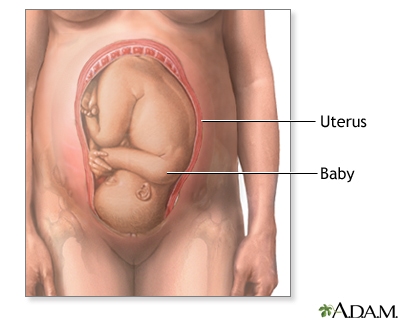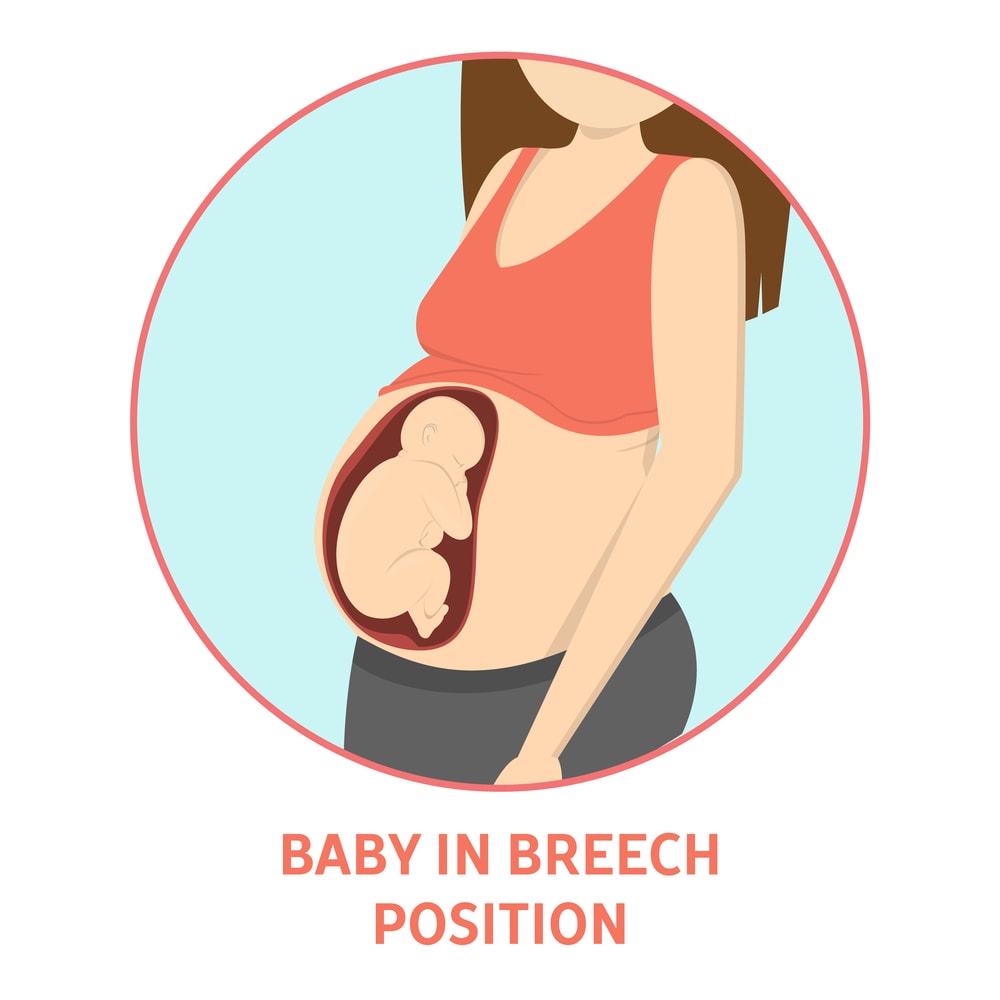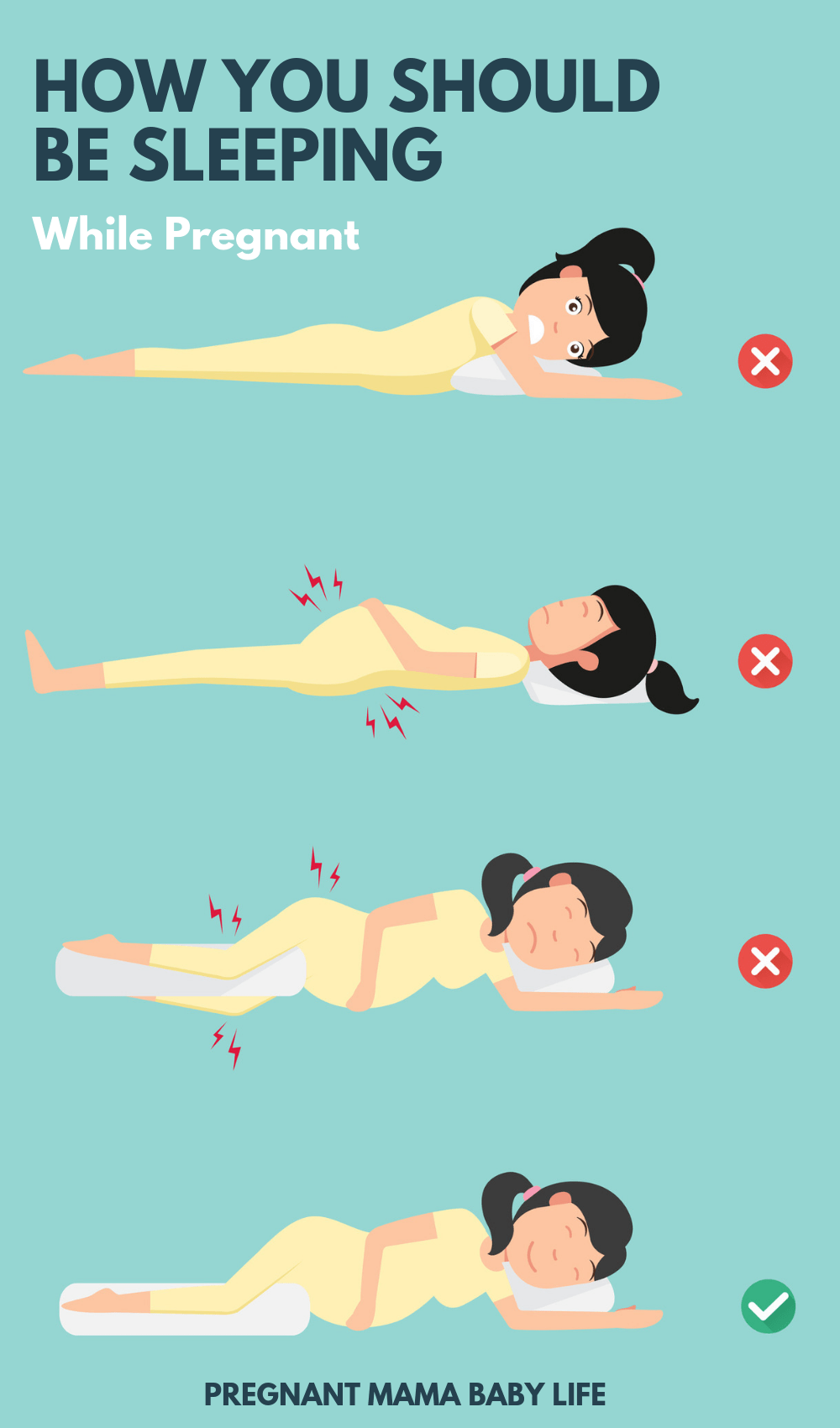How to Tell If Baby Is Breech & Surprising Things to Fix It
In this post we are taking a look at how to tell if a baby is breech, how to prevent the breech position and things you can do to turn a breech baby. Get ready, this is an information packed post!

During the last several weeks of pregnancy, you and your baby start getting ready for the final countdown.
The finish line is inching closer, and your both getting into position.
Only, maybe your baby didn’t get memo during the team huddle.
Maybe he’s creating his own play. Maybe your baby is breech!
Then again, maybe not. No worries. We got this.
Here’s the low down on what the position is and how to tell if your baby is breech.
This post may contain affiliate links. This means if you make a purchase, we may earn a commission. We only recommend products we trust and love. You can read our full disclosure here.
Contents
What Is a Breech Baby Anyway?
A breech baby is a baby that’s in the “wrong” position in your womb close to delivery time.
More specifically, it means your baby’s bum (or even feet) are sitting at the bottom of your uterus, and their head is closer to your chest.
The safest position for your baby to be in at the time of birth, is head down, like the image below.

Luckily, only 1 out of every 25 babies will be in the breech position at the time of birth.
This is what the breech position looks like:

When Is Breech a Problem During Pregnancy
Breech baby before 30 weeks:
Typically a breech baby is not big deal before 30 weeks. Just make sure to keep moving, keep walking and avoid leaning back while sitting too much.
Breech Baby Between 30-34 weeks:
This is the ideal time to flip your baby if they are in the breech position.
There is still enough fluid in your uterus for baby to move easily, when a few simple techniques are applied, such as a forward-leaning inversion.
Breech Baby at 35 or 36 Weeks:
If your baby hasn’t flipped by this time, your doctor or midwife may start instructing you to do techniques to flip the baby, and may even talk about scheduling a manual version.
We’ll talk more about these techniques in just a bit.
Breech Baby at 37-38 Weeks:
Babies are unlikely to turn on their own at this point, but it’s still possible.
Now’s the time to have the what now discussion with your provider and determine if you will need a c-section, or if it’s safe for you to have a vaginal birth.
The Problem with the Breech Position
The problem with your baby being in the breech position comes down to the birth of your baby.
It can make it more complicated, and add more risks.
This is why a lot of doctors, especially in the US, won’t deliver a baby vaginally when they are breech.
The Different Breech Positions
There are few different types of breech positions.
This is important to note when trying to figure out if your baby is in the breech position, as you’ll be looking for feeling for their head, bottom and limbs.
The most common usually follow under one of the following three categories; The complete breech, the incomplete breech and the frank breech.

Complete Breech
The complete breech position is where your baby’s bottom is pointing down and his legs and feet are folded up near his bottom, in the typical “fetal position.”
Incomplete Breech
An incomplete breech is where your baby is in the complete breech position as above, but with one leg extended upward toward his head.
Frank Breech
Lastly, a frank breech is when your baby’s butt is pointed downward, but their feet are pointing straight up toward their head.
Footling Breech
There’s one other more common type of breech not pictured above, and that is footling breech.
This is when one (or both) of your babies feet dangle down and try to enter the birth canal first.
Breech Baby Causes
Reasons for a breech baby are usually unknown.
However, there are things that can make it more likely for a baby being breech.
Risks for a breech baby
These are a few of the more common “causes” of a breech baby:
- If you’ve already had a baby.
- Being pregnant with multiples.
- If there is too little or too much amniotic fluid.
- Having uterus issues, such as an odd shaped uterus or fibroids.
- Having tight or asymmetrical uterine muscles.
- Having placenta previa, which is where your placenta is at the bottom of your uterus.
Birth Defects
Although rare, sometimes a baby can be breech due to specific birth defects that make the umbilical cord shorter and it “pins the baby down” toward the bottom of the uterus.
The baby simply has no way to turn around.
Sitting
Another thing that could cause a baby to be breech. Our current lifestyle!
Mostly sitting too much. I know the struggle is real!
But unfortunately, this is a very common cause of baby being breech.
If you have an office job, or a job where you have to sit alot, it can be hard not to….sit. But there are things you can do:
- Move as often as possible. Walk, stretch, dance. Whatever keeps you going!
- Take breaks often and move around.
- Using a birthing ball instead of a chair. This helps big time with pregnancy back problems as well.
- Avoid reclining chairs or leaning back too often.
- When sitting, lean forward. I would keep my legs open wider and rest my belly in front of me.
These things will help encourage your baby to move into a better birthing position.
How to Tell If Baby Is Breech
So, how can you tell if your baby is breech?
At your doctor’s office, your doctor or midwife with feel your belly and try to determine the position your baby is in.
If they think your baby may be breech, they will likely order an ultrasound (Or sometimes do one in the office) to see your baby’s actual position.
How to Tell If Your Baby Is Breech Without an Ultrasound
One way to determine if your baby is breech without an ultrasound is to use palpation.
Palpation is simply a fancy term to describe “feeling” your baby with touch.
By palpating your belly, you’ll be able to figure out how your baby is sitting in your belly.
I will say that sometimes providers such as your doctor or midwife aren’t always able to accurately palpate your baby’s position.
That’s because it can take quite a bit of time, which they often don’t have for each patient.
This means that you are probably the best person to really figure out how your baby is positioned based on touch alone.
Here is a great video explaining how to feel what position your baby is in, and tell if they are breech or not.
Belly Mapping To Determine Breech Position
Another technique way to tell if baby is breech without an ultrasound is Belly Mapping.
Belly mapping is a technique developed by Gail Tully of spinningbabies.com.
Basically, you feel for your babies position by feeling for their head, their punches and kicks, and listening for their heartbeat.
Using these clues, you’ll have a good idea of your babies position.
Typically with belly mapping you use a marker or paint to help you create a “map” of your baby right on your belly.
Supplies Needed to Belly Map
- Your hands
- A fetoscope or a handheld doppler (optional) It’s not recommended to use handheld dopplers at home for regular use to find your babies heartbeat.
- A belly safe marker or paint
- A baby doll or animal with long arms and legs
Heres a great video explaining it from Mama Natural. (By the way she teaches an AWESOME birth course that helps you reduce the pain of birth. You should read my full Mama Natural Birth Course Review.)
How to Feel Your Belly to Tell If Your Baby Is Breech
To feel if your baby is breech on your own belly, follow the following steps.
It works best right after you have seen your provider and they have palpated the baby and located their heartbeat.
This helps give you a good idea of where baby’s back is.
1. Find Your Babies Head
- Lay on your back in a relaxed position.
- Starting low in your pelvis, gently but firmly feel each section of your belly. You are feeling for the head. It will feel like a small, very hard ball. (Sometimes the bottom can be mistaken for the head, so keep this in mind, although it tends to be softer than the head.)
- While palpating think carefully about the movements you feel. Soft hits are more likely to be hands, while harder ones are likely to be their feet.
2. Visualize Where the Heartbeat Was
- This step is helpful, but not always necessary. If you just had your provider find your babies heartbeat, it may give you an idea of where your babies back is.
- Use this to gently feel for the curve of your baby’s back
3. Find the Babies Bottom
- Now that you know generally where your babies head and chest is, it should be easier to find your babies bottom.
- An easy way to tell if your pushing on their head or bottom, is by pushing gently on the bump toward the other side of your body.
- If your whole uterus and bell get pushed over then it’s probably their bottom.
- If you only get a local, gentle wiggle, it’s probably their head. (Since the movement stops at their neck.)
By feeling how your baby is positioned you’ll be able to tell if your baby is in the breech position.

Signs your baby is breech
If you aren’t able to feel your babies position or see it on the ultrasound, there are other signs that could indicate that your baby is breech.
None of these signs individually mean that your baby is breech, but multiple signs, plus a gut feeling, means you should probably check with your doctor to see what position your baby is in.
1. Lots of pressure in your rib cage
When a baby is in the head down position, their head rests on your pelvic bone.
Many moms complain of this pelvic pressure toward the last few weeks of pregnancy.
If your baby is breech, you may feel a lot of pressure to one side of your rib cage, or both even, instead of your pelvis.
It can also feel harder to breathe since the pressure is up under your lungs.
2. Harder kicks in the Pelvis
Another sign that your baby may be breech, is that you feel harder kicks in your pelvic areas.
This could mean that your babies feet are hanging out near the birth canal.
3. Lighter Punches Higher up
You may feel lighter “punches” in your upper abdomen since the hands tend to hang out near your baby’s head.
So, if your feeling hard hits at the bottom and softer hits at the top, your baby could be breech.
4. Finding Babies Heartbeat Higher up in Moms belly
If your provider keeps hearing your babies heartbeat higher up on your belly, it could be a sign of a breech baby.
This means that his upper body is higher up.
This isn’t always the case though, sometimes the sound can transfer around because of the amniotic fluid, so it’s not always an accurate sign.
5. Failure to Engage
If you’re getting close to your birth date, and your baby still hasn’t engaged, or “dropped” it could be sign of breech.
In a normal presentation, your baby’s head would start entering closer to the birth canal, causing a shift in your body as your baby gets lower.
Although, babies engage at different times, so don’t worry too much if this is the only sign you have.
Of course, none of these signs alone can accurately tell you if your baby is breech or not.
However, if you have several of these signs and are concerned your baby may be breech, then make sure to talk to your doctor or midwife.
How to prevent a breech baby
Of course, your baby is going to do what your baby wants to do.
But there are some things you can do to help prevent your baby from getting into the breech position.
The best thing you can do is pay attention to your body mechanics and do things each day that promote a healthy pregnancy and uterus.
Here are some of the easiest things you can do:
Walking
Walking daily during pregnancy can help you have a healthy pregnancy and an easier birth.
Moving regularly will also help stretch and loosen your pelvic muscles, which could help prevent a breech baby.
Sitting in the correct position
Sitting in certain positions could encourage your baby to turn breech. Ideally, you want to sit with a forward lean.
For example, when you are in a chair, sit with the pressure sitting on your thigh muscles instead of your tailbone.
For example, at my job, the chairs were designed for a lounge sit.
Instead, I made sure to lean forward, resting my belly in between my legs instead.
Also, make sure your knees stay below your hips.
Lastly, a great position to sit in regularly is the “criss-crossed” position. You know, the way we used to sit as kids in the classroom.
You can sit this way on the floor when hanging out at home, or you can take your shoes off at work and sit this way in your chair if appropriate.
Although I do find you can get away with way more when you’re pregnant.
Finally, you can try a birth ball to sit in instead of a chair.
Your body will naturally align better on a ball for a birthing position.
Sleeping positions to prevent a breeched baby
Finally, pay attention to how you sleep at night.
The position you sleep in can affect your babies position.
Did you know there are even sleeping positions to turn a breech baby?
According to Spinning Babies, you want to think of your uterus as a hammock, and you want to sleep in a position that allows your babies back to rest in that hammock.
Ideally, you want your babies back resting on your belly curve.
Make a Nest
The easiest way to do this is to do this is to make a “nest” to rest your belly in while sleeping.
You can pile up pillows under your hips and chest and rest your belly in the nest.
Side Sleep
You can also sleep on your side (you should be sleeping on your left to keep baby off of the main blood vessel in your body for both of your sakes.)
You’ll want to put a pillow under your knee and leg to keep your pelvis open.
Instead of lying with your top leg directly over your other leg, you’ll want to put it farther over to tilt your pelvis slightly downward like the diagram below.
This is one of the best sleeping positions to turn a breech baby.

How to turn a breech baby
So, if you’ve been having symptoms that point to a breech baby and then figured out your baby’s is position by palpation, you really should talk to your provider.
They can help definitively tell if your baby is in the breech position.
So let’s say you’ve done all that. And you know your baby is breech. (AND your more than 30 weeks pregnant.)
Now what??
Now it’s time to work on turning that baby!
These techniques should only be done after you discuss if they are safe for you and your baby with your provider.
To start with, make sure to pay attention to the sleeping positions to turn a breech baby that we talked about above.
Then consider adding in some of the following tips.
Forward Leaning Inversion
The forward leaning inversion is an easy exercise you can do daily to help get your baby in the right position.
There are warnings for this technique though.
You should not do a forward-leaning inversion if:
- You have high blood pressure
- Risk of stroke
- Glaucoma
- Heartburn
Again, always talk to your provider first.
Benefits of the forward-leaning inversion:
This position is great because it can:
- Untwist, lengthen and stretch tight uterine ligaments
- Help your baby enter a head down position
- Reduce pregnancy back and hip pain
Here is a simple way it can be done at home.
Make sure to read this fantastic article before attempting the forward-leaning inversion.
Chiropractics

Prenatal chiropractics could help turn a breech baby too.
With all the changes happening in your pregnant body, it’s easy for your spine and hips to become misaligned.
Getting your body adjusted with the Webster technique (a special chiropractic technique used during pregnancy to adjust the pelvis) can help put your body in an optimal state.
Pathways of Family Wellness explains it like this:
While chiropractors can’t turn breech babies, what they can do is gently and specifically adjust a mother’s spine and pelvis back into a proper balanced state, reestablishing normal physiological function.
In this balanced state, the baby can do what it’s designed to do, find the best possible position for itself for birth.
If you can, start looking for a well-rated chiropractor in your area who specializes in the Webster technique.
It could just help your baby turn, and give you and your baby an easier time birthing.
Moxibustion
Moxibustion is a traditional Chinese medicine technique where you burn an herb called mugwort near both pinky toes of the body.
It’s used to apply heat to a specific acupuncture spot on the body.
It is believed that this technique can be used to help turn a breech baby.
Science and Sensibility did a literature review of the current studies available on this approach.
According to their analysis, Moxibustion alone wasn’t very effective, but when combined with acupuncture treatments and postural techniques it has been shown to be effective.
Basically, this would be worth a shot, but it seems the acupuncture and body positioning exercises are a must to go along with it.
Pelvic Tilts
Pelivc tilts is a technique used to allow baby to get “unstuck” from the bottom of your pelvis but basically laying upside down on your back.
This then allows baby to move around more and get into a better position themselves.
To do the technique you can use a birthing ball (deflated 50%) and use it to support your pelvis like the video below.
If you don’t have a ball readily available you can also use lots of pillows stacked on top of eachother.
You can do this technique 2-3 times a day, for 20 minutes each. As long as your ok’d to do so by your provider.
External Cephalic Version
Lastly, if you are still breech by 37 weeks, your health care provider may want to do an external cephalic version to help rotate your baby.
This is when your provider manually trys to rotate your baby by pushing on your baby.
There are risks involved in the procedure, so they usually have you stay a while to monitor you and your baby.
They will also likely give you medication through an I.V. to help with the procedure.
It can be uncomfortable and sometimes even painful, as they push.
Most mom’s describe it as an intense pressure.
It has a 60% success rate at turning your baby. Making it easier for birth and can help you avoid a C-section.
Here’s a video of one mom getting External Cephalic Version.
If you are concerned your baby may be breech, make sure to talk to your provider and find out safe ways you can reposition your baby.
References:
https://medlineplus.gov/ency/presentations/100193_1.htm
https://www.mamanatural.com/turn-breech-baby
http://americanpregnancy.org/labor-and-birth/breech-presentation
https://spinningbabies.com/learn-more/baby-positions/breech/







